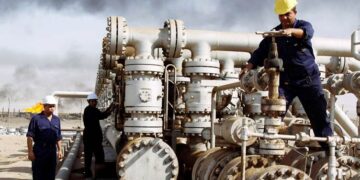This is a place that comes to life at night.
Stroll through any of the bazaars or along the waterfront when the streetlights come on, and it is as though the entire town is there with you.
Ahvaz is the capital of Khuzestan province, situated in Iran’s oil-rich southwest. Although it may not attract visitors year-round like cities such as Isfahan or Shiraz, it is a popular vacation destination from mid-fall to mid-spring due to its warm weather. The hospitality and generosity of its locals also make it an enjoyable place to visit.
“The nine bridges erected over the Karun River make Ahvaz the city with the most bridges in the Middle East”
Flowing through the heart of the town is the Karun, which is Iran’s longest and only navigable river. The shores of the Karun are the liveliest source of recreation in Ahvaz, bustling with activity at all hours. The evening boat excursions are in high demand, particularly during the Nowruz or New Year holidays. The cafes and restaurants along the river remain open until late, and the locals love to take their instruments by the waterfront, singing and playing into the night.
However, the ambience becomes even more charming when the bridges light up. The city of Ahvaz features nine crossings over the Karun River, making it the city with the most bridges in the Middle East. While all the bridges connect the eastern and western parts of the town, each one has a unique architectural style.
The oldest bridge in Ahvaz is the Pol-e-Siah, or Black Bridge, named for the black colour of its foundation. Constructed in 1929 to pass trains, it is also known as the Victory Bridge for its role in the Allied victory in World War II.

The White Bridge, also known as Pol-e-Sefid, holds the distinction of being Iran’s first metal suspension bridge. It symbolises Iran’s modernization during the first Pahlavi era (1925-1941) and was constructed immediately after the Black Bridge. Sentap, a Swiss company, led the project and sent a German couple, both civil engineers, to oversee the construction of the bridge in Ahvaz. The chief engineer and husband died shortly after the completion of the first grand arch, but his wife oversaw the project’s completion in 1936.
The White Bridge remains functional to this day and is a popular gathering spot, serving as an iconic landmark of Ahvaz, much like the Eiffel Tower is to Paris.
Pol-e-Tabia’t, also known as the Nature Bridge, connects Saheli Park and Laleh Park, which are two municipal parks situated on either side of the river. The bridge is solely for pedestrians and has numerous benches and fishing spots. It is an excellent location for sunrise and sunset photography.
The seventh bridge, also known as Pol-e-Haftom, has the longest artificial waterfall in the Middle East. The blending of light and colour upon the water at night is a magnificent sight to behold.
The eighth bridge, also known as Ghadir Bridge, is the longest cable bridge in the Middle East, stretching 1014 metres.
Ahvaz, due to its proximity to the Iraqi border, suffered severe bombardment during the Iran-Iraq war in the 1980s. Among Iran’s provinces, it suffered the most damage, with residential buildings bearing bullet holes to this day. To this day, the remains of martyrs are still being discovered from the Karun river. Any local will recount their personal war experience.

Although the people of Ahvaz have faced many hardships during the war, they have managed to remain lively and energetic. They love spending time outdoors, picnicking, smoking shishas, and having fun. It’s common to see cars with full-blast stereos and passengers jamming along the boulevards. Some restaurants even offer live music, such as Taje Soltan, which is famous for its Iranian/Lebanese cuisine, local seafood, and Arab melodies that will make you want to dance.
Despite the ravages of war, Ahvaz’s historical sites have stood the test of time. Some of these sites date back to the first Pahlavi era and are worth visiting. One such site is the Mapar House on Khansari Street, known for its brick facade, wooden arches, and coloured glass windows.
Mapar House, named after its original owner Abdul Majid Mapar, was built in the 1920s and underwent restoration in 2001. It is now a national landmark that attracts hundreds of tourists daily, especially during Nowruz. The courtyard of Mapar House features an iconic palm tree known as “The Sulking Palm” due to its curved trunk, as well as a turquoise-coloured fountain at its centre. Visitors can enjoy traditional beverages such as the distilled palm tree water called “mai laqah” at the soda shop or “sharbat khaneh”.
If you take a short walk from Mapar House along the promenade of the Karun towards Saheli Boulevard, you will come across Hotel Ghoo. This building, dating back to the end of the Qajar dynasty, showcases a blend of Persian and European architectural styles with walls decorated with an array of tiles, mosaics, mirrors, plastering, and brickwork. Although Hotel Ghoo has not yet reopened as a hotel, its café in the courtyard is open to the public, with the proceeds going towards the restoration of the site.
No trip to Ahvaz is complete without strolling through the numerous falafel stalls on Lashkar Abad Street in the Arab district. While until twenty years ago, Lashkar Abad was considered a dangerous area, today it is one of the liveliest in town and buzzing with tourists who travel far and wide to savour its falafels. Lashkar Abad is equally famous for its samosas, baklavas, bamiyehs, and coffee. Small wonder it is called the tastiest street in town!
The song Labeh Karun (By the Karun), etched in the collective memory of the Iranian people, was first performed in the pre-revolutionary era by Aghasi, a native of Ahvaz. Initially an itinerant oil salesman, Aghasi often sang on the job, which led to his popularity as a singer. After making it big in the cabarets of Tehran, he would occasionally return to his hometown and perform in Café Khayyam overlooking the Karun. Although the once-thriving café has stood abandoned for the past 25 years, it still evokes nostalgia.
“Traces of Ahvaz’s past testify to an era of peacemaking and bridge-building”
Ali Kharazi, a tour leader based in Ahvaz, believes tourism here could be more substantial. He acknowledges his city was most vibrant in the Pahlavi era and has yet to recapture its past glory. He also feels more must be done to revitalize the Karun, whose water level has been shrinking. “No other city in Iran has a river like Karun running through it,” he states. “There’s so much potential in Ahvaz, so many more possibilities for leisure and recreation – especially along the Karun – but unfortunately, not as much insight or initiative on the authorities’ part.”
It may come as a surprise for some that there was once a Polish community in this city. During World War II and the Nazi invasion of Poland, a large number of Polish refugees arrived in Iran via the Soviet Union and Caspian Sea. It is estimated that between 115,000 to 300,000 refugees sought shelter in Iran during this time. Those who ended up in Ahvaz found refuge in an area that became known as Camp Polonia, now called Campulu. After the war, some of the refugees returned to Poland, while others chose to stay in Iran permanently. They settled down and started families in their new homeland.
They eventually founded a Polish schoolhouse and even a Polish-language newspaper. The Cemetery of Ahvazian Polish, where 102 Poles are buried, was inaccessible for years but is now open to the public as a historical attraction. Kharazi recalls a participant in one of his tour groups who had travelled from Poland to find their ancestor’s tombstone.
The Armenians were another group of refugees who settled in Ahvaz at the onset of WWII. As the social fabric allowed people of different faiths and denominations to coexist, the Armenian community also established its place of worship. Soort Mesroop Church on Mostafaei Street (near the White and Black Bridges) is a monument to the city’s Armenian legacy.
Sheida Danianian, proprietor of the former Armenian school adjacent to the church, explained to The New Arab that the Armenian refugees typically stayed in Ahvaz for two and a half to three years. Many were welcomed as guests into the homes of the town’s Arab community. “With hospitality playing a significant role in Arab culture, their doors were always open to those in need, and they hosted their Armenian neighbours with open hearts,” she says.
The Armenian population in Ahvaz has decreased over time. Out of the original 12,000, only four or five individuals remain in the city today. While the public’s access to Soort Mesroop is limited, the former school has been converted into an art and cultural centre that is open to all. The centre is headed by Ms. Danianian, who has designated one of the schoolrooms as a memorial to the Armenians of Ahvaz through a collection of old black-and-white photos.
Today, few Iranians, Armenians, or Poles remember such chapters in their history. The origin of the name of the neighbourhood of Campulu is a distant memory. However, evidence of Ahvaz’s past demonstrates an era of peace-making and bridge-building. These bridges not only connect different parts of the city but also bring cultures together that might never have intersected. In a world that is often driven towards closing borders, unification can be achieved through bridges.





























